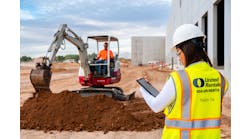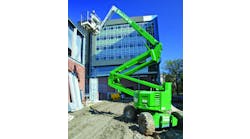Your customer base is changing. You probably still deal with many of the same companies when it comes to renting or selling aerial work platforms and telehandlers, but those companies have changed internally. What once was an experienced English-speaking work force has gradually shifted toward a younger work force that doesn't necessarily speak English as its first language.
Nearly one out of every four construction workers in the United States today is Latino, and the percentage and the absolute number of Latino construction workers, particularly non-native Latinos, is growing. Unfortunately, more than two thirds of construction-related accidents occur among these workers.*
To help ensure that workers are able to operate aerial work platforms, ANSI Standards state that if you are a dealer/rental company (defined as “a person or entity who buys from a manufacturer or distributor and who generally sells, rents and services equipment”), you have a responsibility to offer appropriate training. While training in both English and Spanish is not mandatory, your company should strongly consider providing operator safety training in both languages as a service to your customers and to help reduce accidents.
The main reason for providing a Spanish-language training course is increased student comprehension. Students understand more when materials are presented in the language they are most familiar with. For instance, if you were to speak Spanish as a second language, could you follow a training course delivered in Spanish and feel as confident as you would if you received that same course in English?
When developing or implementing any training program, it should be the industry's shared desire to ensure that training is available and conducted on a consistent basis. As a starting point or refresher, I urge you to become familiar with the ANSI A92.5 and A92.6 Manual of Responsibilities. It clearly lays out the responsibilities throughout the chain of ownership and equipment use.
In general, the dealer or rental company is required to offer appropriate “training” to facilitate owners, users and operators to comply with requirements regarding the inspection, maintenance, use, application and operation of the aerial platform. It is important to note that ANSI requires that a person be trained for the class of equipment he or she is operating. The dealer/rental company must also conduct “familiarization” upon delivery, which includes providing information regarding the control functions and safety devices, and identifying and confirming the location of the appropriate manuals stored on the machine to a person designated by the receiving entity. It is the responsibility of the owner/end-user to ensure that their employees operating the equipment are properly trained.
While the content of a training program is defined by ANSI, there are some additional challenges that need to be considered when delivering operator training in Spanish. For example, direct translations do not always work. For example, the phrase “Non-marking tires must be clean before use” translates to, “The eraser must be clean before use” — obviously something was lost in the translation.
Using a translator can also be ineffective. It slows down a course and does not, alone, ensure understanding. Many translators are not aware of technical terms or construction practices. There are also several Spanish dialects that need to be considered. The word “llanta” means wheel. In some countries it is the entire assembly, in others it is just the tire.
There can also be a cultural difference when delivering training. English training practices are a bit rigid. Spanish speakers generally respond best to a highly interactive, collaborative environment. A more lively presentation of material is more effective.
So, our mission is to develop an excellent, Spanish language operator training program. How do you go about it?
Step one: Talk to your customers
Find out first hand their challenges and perceptions. See what issues they believe they encounter with their Latino workforce. Learn what they like and dislike about the training they currently receive and why.
Step two: Find the right trainer
Whether you employ that person full time, part time or as a contractor, find someone who speaks Spanish as his or her first language and understands the construction environment and the equipment used in the industry.
Step three: Find the right resources
Again, use training materials that consider the cultural differences. Many can be obtained from the equipment manufacturer. Then enroll your trainer in the appropriate manufacturer-sponsored train-the-trainer courses. This will enhance their knowledge of technical content and help polish their training skills.
Step four: Market your program
Based on what you learn from talking to your customers, you should have all the ammunition you need to offer them operator training that meets the needs of the Latino worker. Communicate the benefits of Spanish-language training with their upper management, their HR department or their risk department, not just the jobsite foreman.
In addition to the requirements set forth by ANSI, it is in your company's self-interest to provide comprehensive operator training. For one, poor maintenance or poor operation of equipment can lead to higher repair bills. Unclear familiarization can lead to increased service calls when nothing may actually be wrong with the equipment. Also, when users fully understand how the equipment works and how to use it they are more satisfied as customers. Excellent training can be a competitive advantage that helps your company stand out from the others.
Training can also be a profit center. Having a strong operator training program is something you can charge your customers for. There is a strong push at contractor and industrial companies to document safety compliance and ensure their people are trained. How you price it, measure it and conduct it can vary, but it can be done. In most cases, people that value free training get what they pay for, and end up paying for it in the long run.
Last, and certainly not least, there is risk reduction. Having a strong training program can lead to reduced workers compensation claims and reduced liability costs, not to mention a possible reduction in insurance costs because of fewer claims.
There are many reasons why you should develop or implement comprehensive operator training programs in both English and Spanish. The most important reason however, is that it's the right thing to do.
David Baxter is director of marketing, aftermarket products and services for JLG Industries, McConnellsburg, Pa.
- 23 percent of construction workers are Latino.
- The number of non-native Latinos workers increased by 914,000 from 2003 to 2006.
- Since 1992, the percentage of accidents by non-native Latinos has grown from 48 percent to 67 percent.
Sources:
-
Bureau of Labor Statistics, Household data annual averages, Employed persons by detailed industry, sex, race; and Hispanic or Latino ethnicity, Table 18, 2005
-
Latino Labor Report, 2006, Pew Hispanic Center, page 23, Sept. 27, 2006
-
Bureau of Labor Statistics, Census of Fatal Occupational Injuries, page 8, 2005
*All statistics provided are for illustrative purposes only. JLG Industries has not participated in the development of any of these statistics, and can neither confirm nor substantiate any of these statistics.





